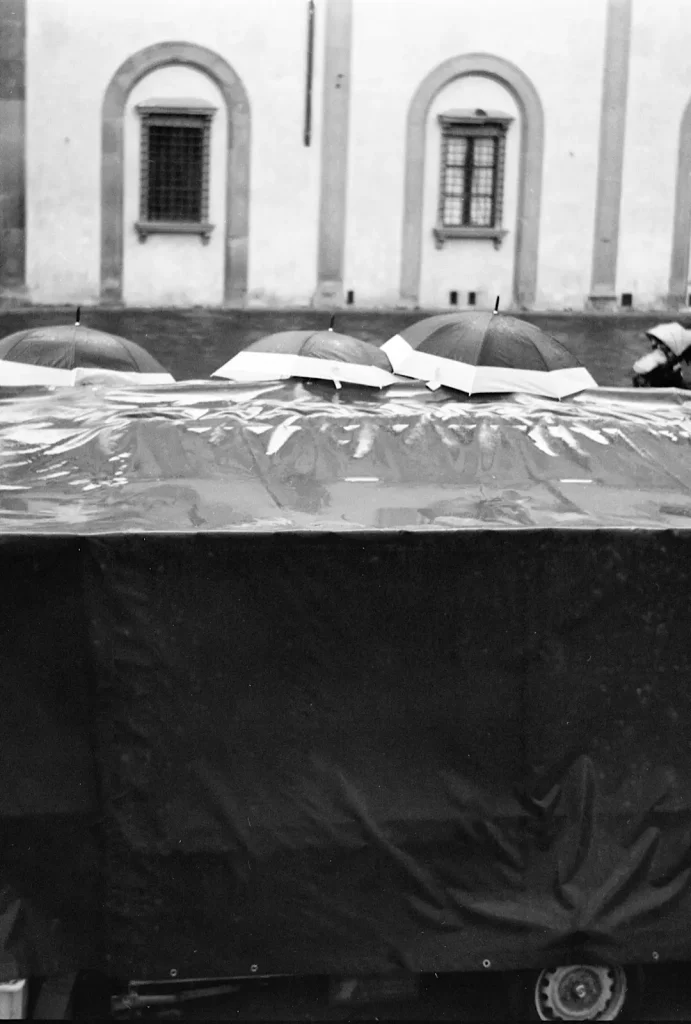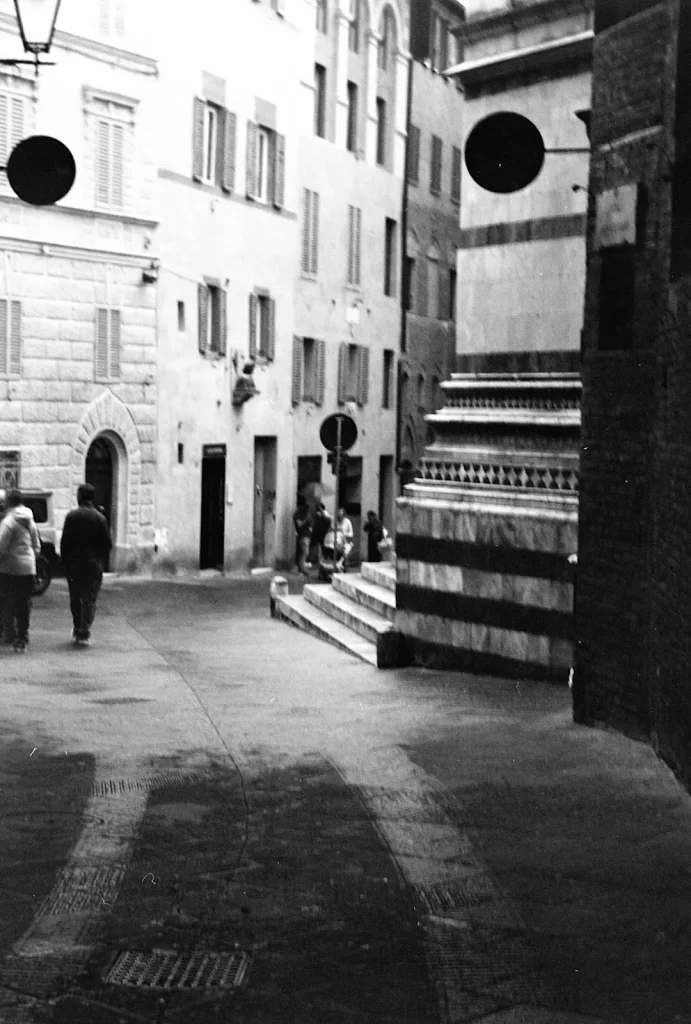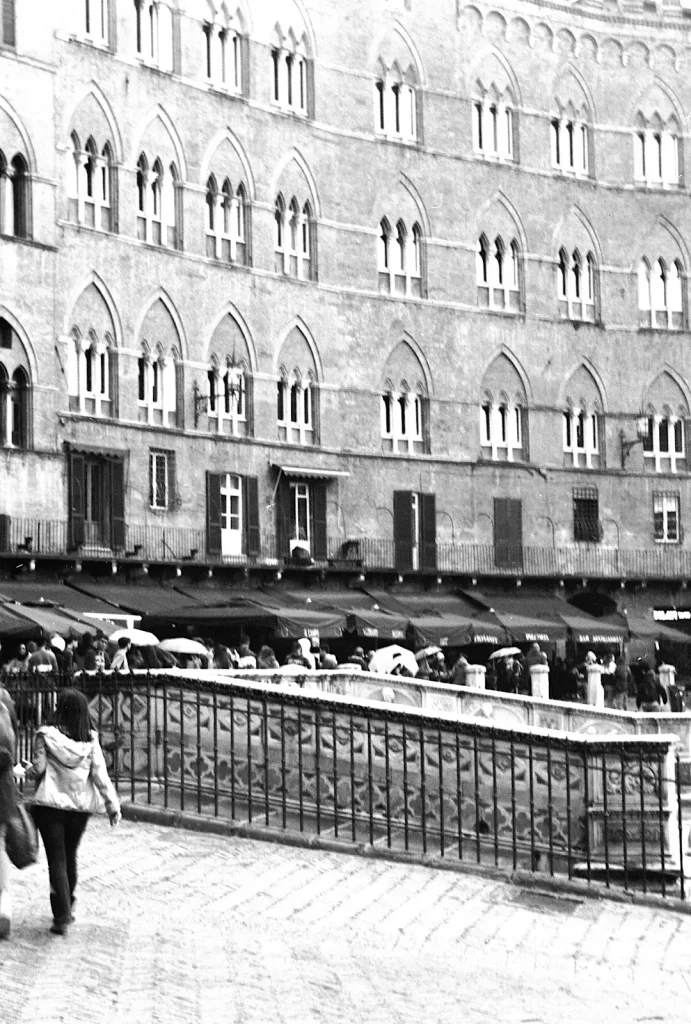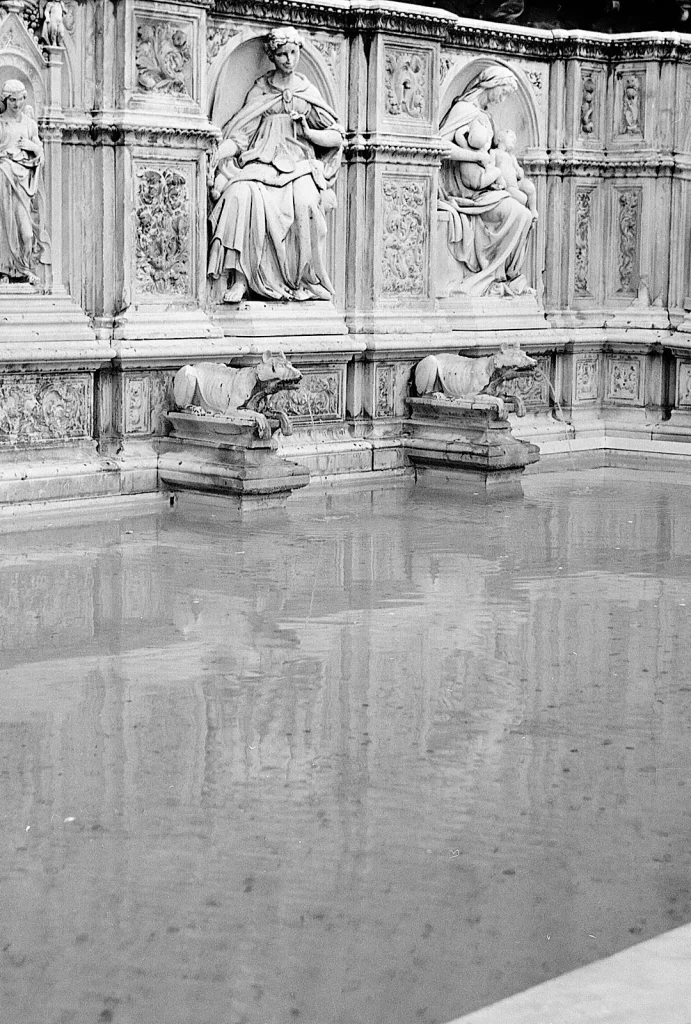The problem I have, and perhaps many other analog photographers, is that I have too many cameras. They are just too affordable and too enticing to someone who remembers how much they would have cost new. Which leads to the second problem: which film do I have in which camera? Usually I have a small field note book with me in which I note date, film, camera and as much as I can about each photo taken on that roll. But of course, for a recent trip to Italy, not only did I forget my tripod, I also forgot my field book. Which lead me to a possibly fatal mistake that eventually lead to this experiment.
The Voigtländer Bessa 1 is a zone focusing camera with (at least my version) a relatively dim viewfinder. I prefer to zone focus much as a street photographer would – f/8 and be there. Set the distance scale correctly and I am in focus from about 6.5 m to infinity. The Bessa 1 has a little circle on the focusing ring to show you maximal depth of field at f/11 and at f/8 it’s just a little bit less. Leave the focus scale set, leave the f-stop at f/8, remember your sunny-16 rules, cock the shutter and go for it.
As the day was rainy and I knew I had PanF in the Hasselblad, so thinking I had it loaded with Tri-X, I took the Voigtländer with me into Sienna instead. It’s a great choice for a camera in the rain because if you have large enough jacket pockets you can just fold it up and slip it in. I had put in the 6×4.5 mask so I had changed my 6×9 camera into 6 x 4.5. This means you get 18 instead of 9 shots, but you have to be careful to stop the number in EXACTLY the middle of the second window or you get some interesting spacing (as in none) between your negatives.
The Voigtländer has a little arrow beneath the shutter button which either points to the film advance knob or the shutter. You can’t cock the shutter unless you have advanced the film and the arrow points to the shutter. Of course this doesn’t mean I remembered to always cock the shutter before I was ready to photograph, but as I’m not the typical street photographer and my subjects (buildings) don’t move very fast, I was able to get the photographs I wanted.
I finished the roll, sat down for a far too expensive coffee in the Piazza and opened the Bessa to change film and take out the mask. Unfortunately, I wasn’t greeted by a tightly wrapped roll of Tri-X, but instead by a roll of Fujichrome Velvia 50, expired in 2004. I’d spent a day in the rain photographing Sienna with two big unknown mistakes – I was underexposed the film 3 stops and I was composing my shots for black and white.
My first thought was just to trash the roll. I had a few pictures on it I would miss but there was one picture I knew I’d taken and I was sure had turned out well. It was a shot of the back of a vendors stand with umbrellas opened and hung on the eaves – I wanted to see it, so I thought I would try and find a way to somehow save the roll.

When I returned home, I turned to the internet. There were conflicting reports of developing E6 film as a black and white negative film, half said it would work, half said it didn’t. To top it off no one had tried to develop a roll that had been so badly underexposed. From my academic training I am a biochemist so I started reading up on the chemistry and developing processes for E6 and for black and white film. Chemically it should work. So I used the information I had been able to find, and decided to go for warmed semi-stand development in 1:100 Rodinal.
I put my Paterson tank in the kitchen sink in a pre warmed bath of 30 degrees water which I kept up to temperature with an aquarium heating rod. I pre-washed the film with warm water twice for 5 minutes then put in the pre-warmed 1:100 diluted Rodinal. I agitated continuously for the first minute then I let it stand in the water bath for 30 minutes, agitated for 30 seconds and then left it for another 30 minutes. In order to try and clear the emulsion as much as possible I stopped it with a 1% acetic acid solution for 2 minutes. Then washed it for three minutes under running water to remove all traces of acid before fixing. Fixed in Ilford Rapid Fixer for 7 minutes, washed under running water for 10 minutes and then the moment of truth. The negatives were there to see but dark and the emulsion was brown, not grey. But there were negatives!

After drying and flattening overnight I scanned and inverted the negatives with the Silverfast AI suite using my old but trusty Epson 4990 photo scanner. During the inversion to a positive I had to use the gradation curves tool in the development suite to pull up the shadow tones but otherwise the negatives were very usable. I was especially surprised as I was printing the negative for which I had taken on this experiment at the tonal range that the film still gave. All in all I would have to say it was a happy end to a possible disaster.


My Instagram account, for my one interested is @festgriff
A big thanks to Hamish for the chance to share this with the analog community. I hope it gives someone else the kick to also try some weird cross processing. Take care everyone and keep on shooting.
Share this post:









Comments
Thorsten Wulff on Fujichrome Velvia – Expired & Developed in Rodinal – By Lee Griffith
Comment posted: 02/06/2019
Thanks for sharing.
Your experience and very smart solution shows why it's so amazing and worthwhile to shoot film.
Comment posted: 02/06/2019
William Parker on Fujichrome Velvia – Expired & Developed in Rodinal – By Lee Griffith
Comment posted: 02/06/2019
Comment posted: 02/06/2019
Joseph Slupsky on Fujichrome Velvia – Expired & Developed in Rodinal – By Lee Griffith
Comment posted: 02/06/2019
Comment posted: 02/06/2019
Tom on Fujichrome Velvia – Expired & Developed in Rodinal – By Lee Griffith
Comment posted: 02/06/2019
Comment posted: 02/06/2019
Michael McDermott on Fujichrome Velvia – Expired & Developed in Rodinal – By Lee Griffith
Comment posted: 02/06/2019
Comment posted: 02/06/2019
John Squillace on Fujichrome Velvia – Expired & Developed in Rodinal – By Lee Griffith
Comment posted: 02/06/2019
Peter on Fujichrome Velvia – Expired & Developed in Rodinal – By Lee Griffith
Comment posted: 02/06/2019
Comment posted: 02/06/2019